MARIANI’SVirtual
Gourmet
February 3,
2013
NEWSLETTER
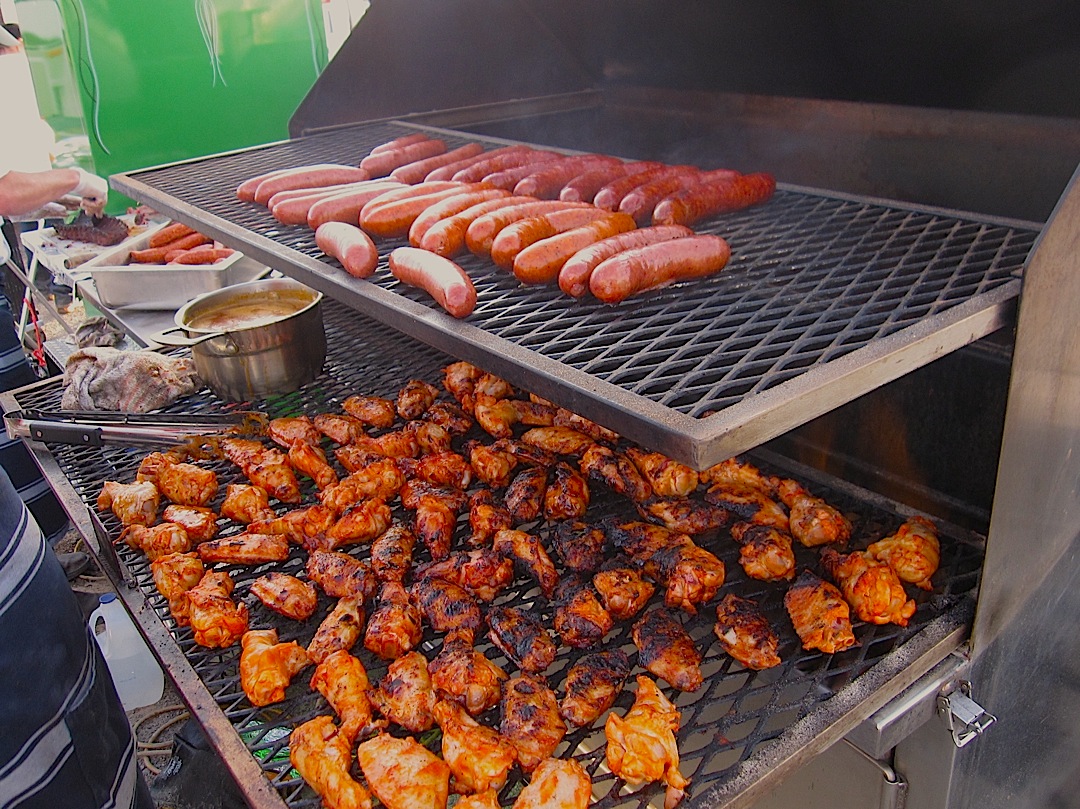
Photo: Christopher Mariani
THIS WEEK
Oh, ATLANTA!
by John Mariani
NEW YORK CORNER
El Toro Blanco
by John Mariani
❖❖❖
by John Mariani

One of the best songs Allison Krauss and Union Station ever did was an ode to Atlanta, in which she croons,
Oh, Atlanta, I hear you calling,
I'm coming back to you one fine day.
No need to worry, there ain't no hurry.
'Cause I'm on my way back to Georgia,
On my way back to Georgia.
The OPTIMIST
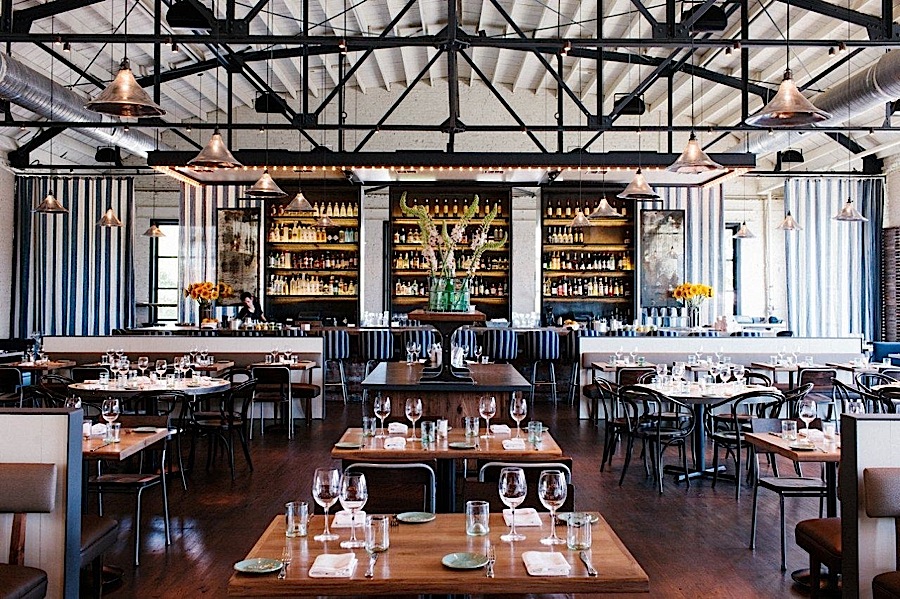
914 Howell Mill Road
404-477-6260
http://theoptimistrestaurant.com
Fry already runs the
admirable Southern restaurant JCT.Kitchen &
Bar, and he hosts the raucous annual Attack of the Killer Tomato
Food Festival, so everybody just knew his `new
place to be next big deal in Atlanta. But
The Optimist is far more than a resounding local
success.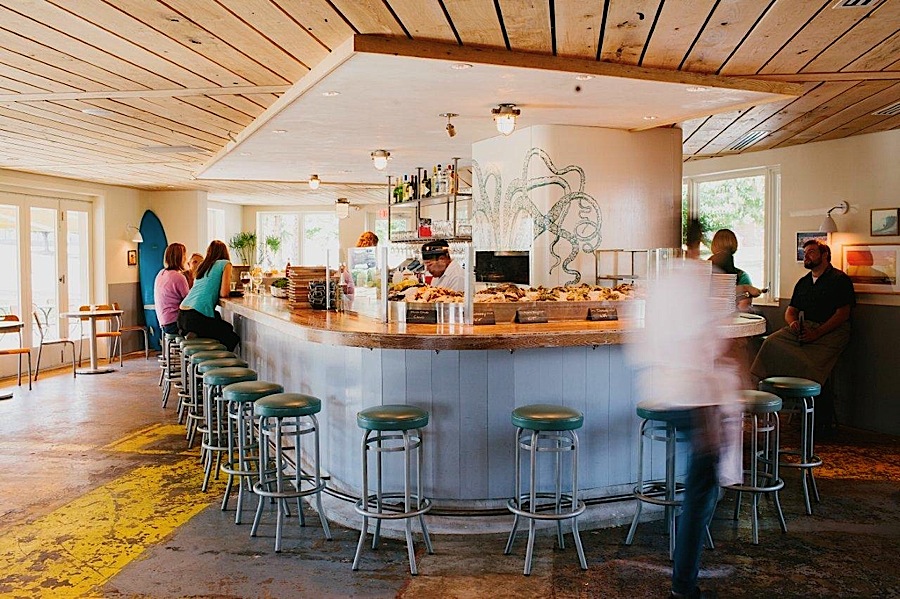 It is an overnight totem of all that is
absolutely, positively, indisputably wonderful
about American food today.
It is an overnight totem of all that is
absolutely, positively, indisputably wonderful
about American food today.
Start with the grandness of
the space—its inspiration taken from a
vintage photo of a seafood plant in Savannah.
The big main dining room, with a white wooden
ceiling trussed with steel rods and a wall of
wine and spirits behind a waxed steel bar
counter, seats 180, with booths covered in
gold “wetsuit” fabric. Every
table is
taken every night by a handsome, casually
dressed crowd drinking cocktails with names like
White Train, made with Death’s Door Whiskey, and
ordering the fabulous frothy she-crab soup with
shrimp toast, spicy glazed Spanish octopus with
watermelon and coriander, and a exceptionally
delicious hearth-roasted red snapper in lime
broth with herb salad. Chef de cuisine Adam
Evans is keeping everything in line nightly, not
letting things get too complicated. Thus,
striped bass comes with butter poached crab and
sweet corn--what could possibly sound better
than that? Sea scallops come with an oxtail
marmalade and brown butter chicken jus.
Even side orders are standouts, like his basmati
fried rice with smoked fish, curry and crushed
peanuts.
The winelist is a very
sensible size and well chosen for foods with
gradations of seasoning and spice, so that many
of the reds--grenache, pinot noir, pinotage--go
very well with this food along with a slew of
fine rieslings sancerre and chardonnay.
If
American seafood gets better than this, it will
have to be sometime in the future. Right now,
The Optimist is American dining at its best, and
that’s why it’s Esquire’s
choice
for 2012 as the Best New Restaurant of the Year.

75 Fifth
St NW
404-892-9111
thespenceatl.com.
Richard
Blais, who
runs the immensely popular Flip Burger Boutique,
has gone upscale without sacrificing the kind of
casual, easy-going American ambiance that has
brought equal attention to his new place, The
Spence, 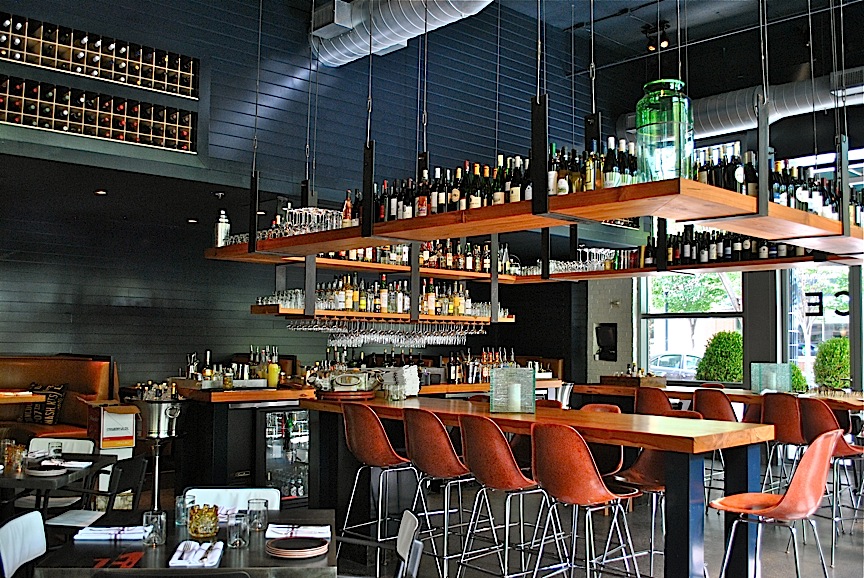 which, he
notes, is a synonym for larder. The restaurant is
done up with lacquered
white brick, reclaimed wood, tartans and zinc and
pine tabletops, with a centrally set open
kitchen. It is one of the Concentrics
Restaurant Group that also runs Two Urban Licks,
Tap Gastropub, and others around Atlanta.
which, he
notes, is a synonym for larder. The restaurant is
done up with lacquered
white brick, reclaimed wood, tartans and zinc and
pine tabletops, with a centrally set open
kitchen. It is one of the Concentrics
Restaurant Group that also runs Two Urban Licks,
Tap Gastropub, and others around Atlanta.
There are some downhome items
here, but each gets a global twist, like the pile
of fried smelts with pickled turmeric.
Pickling is rife here and it adds tremendous
flavor to a dish like shrimp tostadas and
guajillo salsa.
Gazpacho is made with melon and is cool and
sweet. One of the best dishes is the lobster
knuckle sandwich (what do they do the rest of the
critter?) with malt vinegar chips fresh out of the
fryer, and for $16 you get a generous slab of foie
gras with sweet green peach and toast.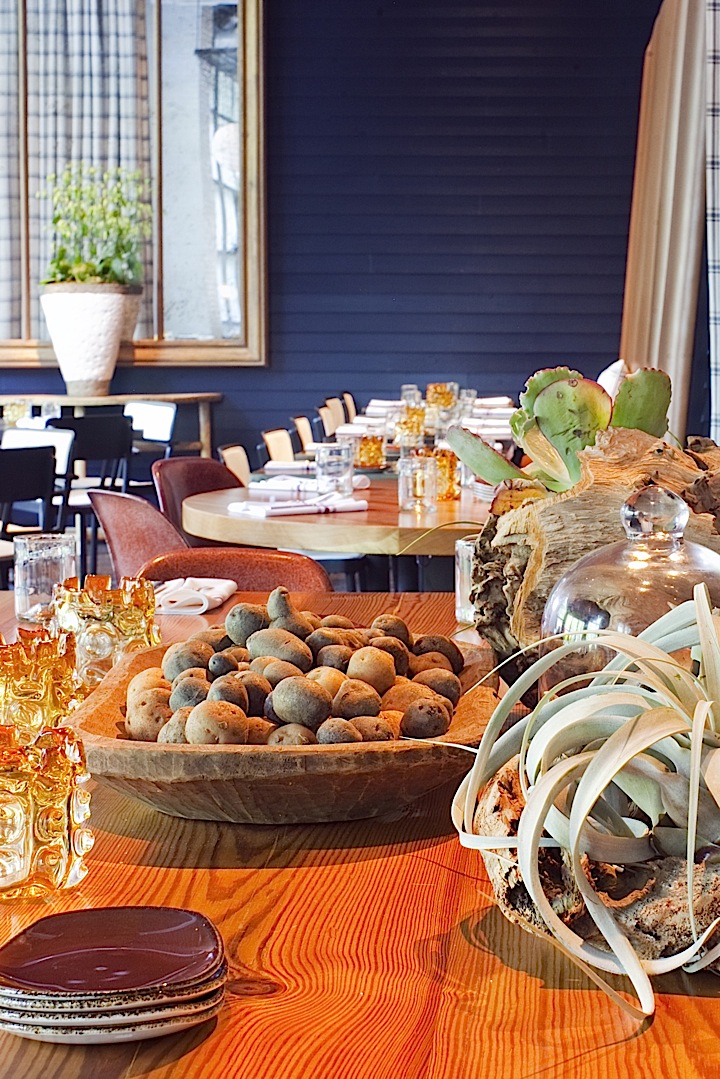 Succulent
lamb leg has Mediterranean overtures of ricotta
gnocchi and honey, while sweetbreads are
deep-fried. One of the most interesting
matches is a plate of bone marrow, quivering
alongside tuna tartare, with fried quail eggs, and
a dish of porcini-infused
noodles comes with sliced lamb tongue, egg and
truffle. The only disappointment--at a time
when mac and cheese rules American menus--was a
bland version of it here, made with headcheese.
Succulent
lamb leg has Mediterranean overtures of ricotta
gnocchi and honey, while sweetbreads are
deep-fried. One of the most interesting
matches is a plate of bone marrow, quivering
alongside tuna tartare, with fried quail eggs, and
a dish of porcini-infused
noodles comes with sliced lamb tongue, egg and
truffle. The only disappointment--at a time
when mac and cheese rules American menus--was a
bland version of it here, made with headcheese.
Deserts include a yuzu semifreddo
with peach sorbet and chili oil that goes a little
too far in heat and a terrific malted barley panna cotta with
popped sorghum.
This is clearly not a menu of
clichés and Blais knows how to to build
flavors without overpowering the prime ingredient.
You'll be surprised by some of the compositions
but you'll never scratch your head over their
resolution. This is food that works hard to
win you over.
The Spence's winelist,
"curated" by sommelier Justin Amick, is done by
titles like "Tried and True" and "Leap of
Faith." The specialty cocktails are a
reasonable $9-$10, and there are some unusual
beers, like Clown Shoes Clementine and Whales
Tale.
The Spence is
open for dinner Monday-Thursday 5-10 p.m. and
Friday-Saturday 5-11 p.m. For more information
visit thespenceatl.com. Prices range from
$6-$28.
```````````````
SOUTHERN ART & BOURBON
BAR
InterContinental Hotel Buckhead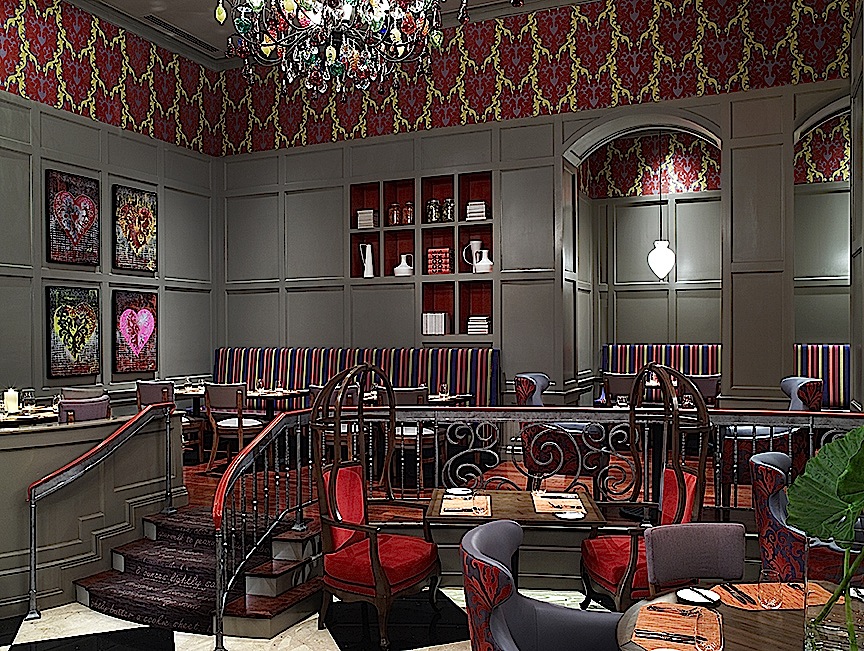
3315 Peachtree Road
404-946-9070
I'm not sure Chef Art
Smith is punning on his own name at Southern Art,
but he is definitely a son of the South, and you
can see it from the moment you walk in, with
hanging country hams and evocative works by local
artists lining the walls. This used to be Au Pied
de Cochon, and its high ceilings, bar up front,
and oversized space will remind you that this is,
after all, a restaurant in a hotel, lacking the
intimacy of a smaller room or the excitement of a
large one like The Optimist with more
cohesion.
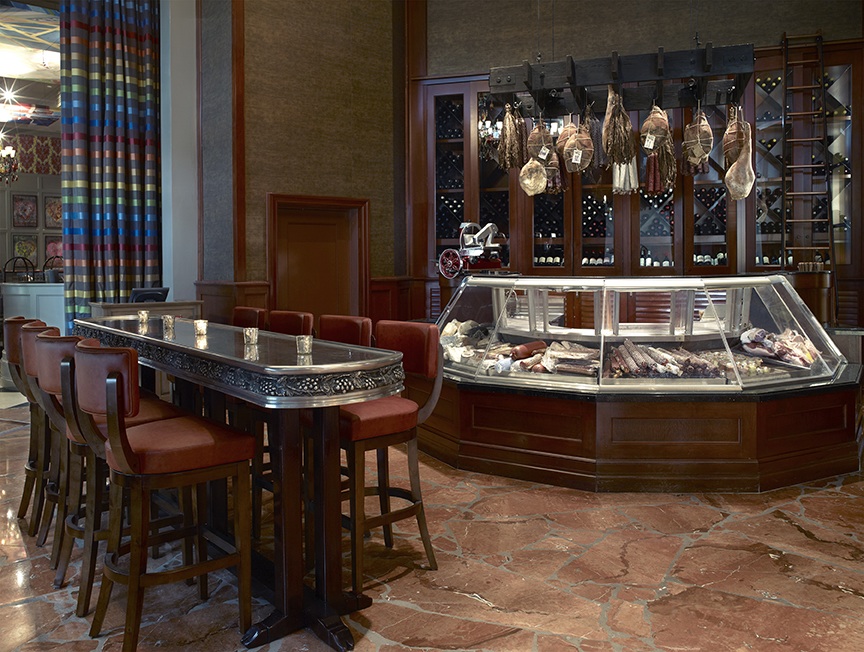 Nevertheless, Smith and
exec chef Anthony Gray are turning out first-rate
versions of classic Southern cooking, starting
with a lavish charcuterie board of American meats
"From the Ham Bar" (left) that are poached, smoked,
and dried, served with various mustards and
relishes--a platter of these goes a long way at
lunch or as an appetizer at dinner for two or
more. The array of hams here include many
I've never seen before--from Moneta, VA; Bremen,
KY; St. Matthews, SC; and more.
Nevertheless, Smith and
exec chef Anthony Gray are turning out first-rate
versions of classic Southern cooking, starting
with a lavish charcuterie board of American meats
"From the Ham Bar" (left) that are poached, smoked,
and dried, served with various mustards and
relishes--a platter of these goes a long way at
lunch or as an appetizer at dinner for two or
more. The array of hams here include many
I've never seen before--from Moneta, VA; Bremen,
KY; St. Matthews, SC; and more.
Combine these with the
nonpareil biscuits here and you have a meal that
demands a good glass of wine and thought of a good
nap for the afternoon. (Odd, then, that th
winelist has not a single bottling from the South.
Surely there should be at least some Virginia
wines here.) But there is so much more that is so
good here, starting with fried green tomatoes with
Alabama pimiento cheese and a jalapeño
pepper jelly--all ingredients sublimated beyond
the usual. Wild shrimp of real meaty
sweetness  come with
Surry sausage, okra, hominy, field peas, and a
shrimp scallion broth, which makes up for in taste
and texture what it lacks in subtlety. The
buttermilk fried chicken here is excellent, served
with a yellow squash casserole, garlicky greens
beans and lush red pepper gravy--all of it
testament to one of the South's great classic
dishes. Duck confit, not at all a classic Southern
item, is very good, too, served with farro grain,
spinach, pickled watermelon rind, and a green
peppercorn reduction.
come with
Surry sausage, okra, hominy, field peas, and a
shrimp scallion broth, which makes up for in taste
and texture what it lacks in subtlety. The
buttermilk fried chicken here is excellent, served
with a yellow squash casserole, garlicky greens
beans and lush red pepper gravy--all of it
testament to one of the South's great classic
dishes. Duck confit, not at all a classic Southern
item, is very good, too, served with farro grain,
spinach, pickled watermelon rind, and a green
peppercorn reduction.
You could easily make a meal of
the side dishes too--especially the superlative
hominy and field pea succotash, and the
creamed corn scented with thyme. Mac &
cheese with smoked bacon was a weak third.
Prices work wonders for the budget: a $12 Buckhead
Express lunch of soup or salad and today's
meat-and-three, iced tea or
soda. or for $10, soup, half a
sandwich, salad,iced tea or soda.
It would be foolish not to have
dessert, with a textbook lesson in red velvet
cake--12 layers of it, with cream cheese frosting
(right)--or
the high and mighty coconut cake. The
caramel chocolate pretzel pie may need some
re-thinking.
This
is comfort food and impossible not to lap up with
gusto. With just that tantalizing edge of
innovation, such beloved classics seem as modern
as menus with global reach. You can learn a
lot about the South at Southern Art.
Southern
Art is pen for breakfast and dinner daily, for
lunch Mon.-Sat., for brunch Sun. First courses
$6-$18, main courses $18-$35.
ALMA CUCINA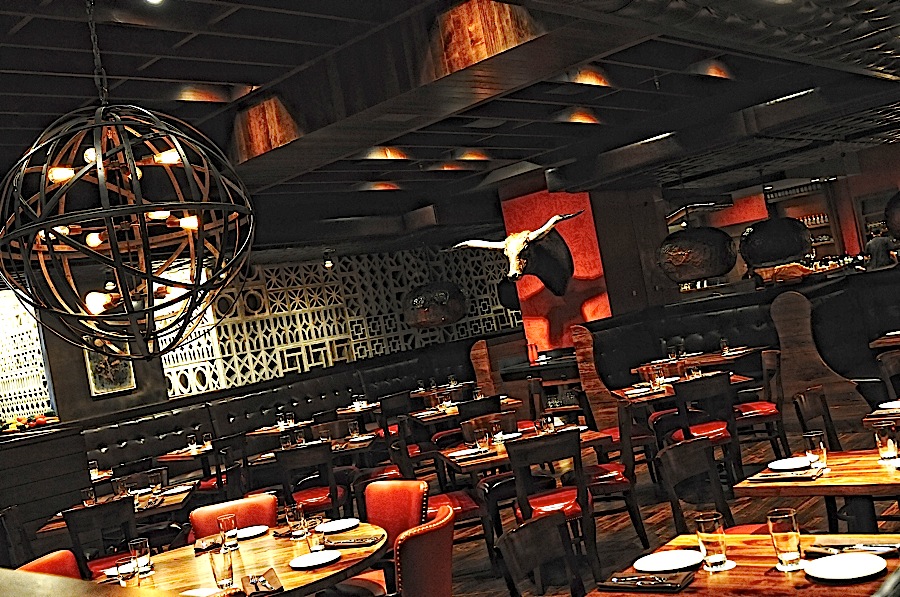
191 Peachtree Street
404-968-9662
www.alma-atlanta.com
Alma
Cucina is an excellent modern Mexican restaurant
in an unfortunate location, set within the atrium
Peachtree Tower Building, making it enticing
enough for lunch but a bit off-putting for
dinner. It's a great looking place, complete
with bull's head, a tequila bar, and an atmosphere
that guarantees you'll have a good time. Try
to snag one of the booths, which are roomy and
convivial all on their own, buoyed by good Latin
jazz.
Executive Chef Clevenger,
formerly at Agave Grill and Mel’s Bar & Grill
in Denver, with a strong résumé in
kitchens in France, has the experience and taste
to push Mexican food further than is usual,
starting with a huitlacoche
empanada with charred tomato,
jalapeño, queso Oaxaca, the sweet herb epazote,
avocado oil, and ranch salsa--the whole adding up to an
explosion of flavors in the mouth, to be enjoyed
with one of the many mezcals carried at the
bar. The pork pibil braised in a banana leaf
with bacon-flavored corn and lavished with green
chile sauce is a far cry from what less ambitious
Mexican eateries attempt. Huaraches
form a separate section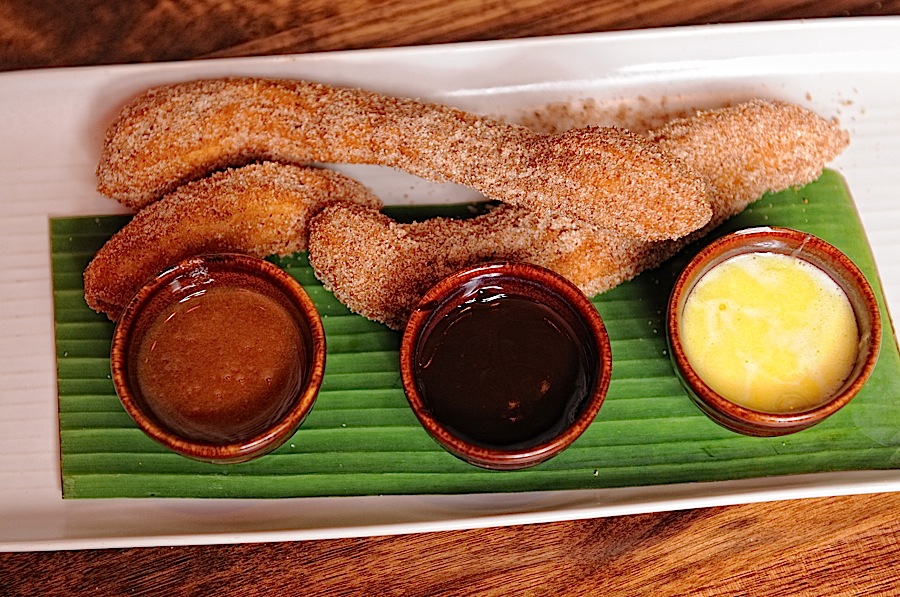 --crispy
corn masa with toppings of braised goat, tomatillo
sauce, chile
rajas, and cotija cheese, or perhaps a
chicken mole Oaxacan
style with pickled onions that really perk the
dish up, sweet onions, sesame seed for a toasty
crunch, and cilantro.
--crispy
corn masa with toppings of braised goat, tomatillo
sauce, chile
rajas, and cotija cheese, or perhaps a
chicken mole Oaxacan
style with pickled onions that really perk the
dish up, sweet onions, sesame seed for a toasty
crunch, and cilantro.
There are also several taquitos--my
favorite stuffed with braised tongue, grilled
onion pickled radish, avocado and green chile. The
chile-based sauces here have just the right bite
to them and you can adjust the heat as you wish.
The nicely smoky roasted chicken mole comes
with mashed plantains, grilled green beans, and
sesame seeds. The only dish I found somewhat
bland was Peruvian-style red snapper with roasted
sweet potato, lime, and aji amarillo sauce, but I
suspect that was only by comparison with the
other, spicier dishes.
The only dessert you have to
think about are the fried, crisp, sugared churros
(left)
for dipping into a dark, rich and creamy chocolate
espresso, salted cajeta, and Meyer lemon
sauces--an irresistible finish with coffee, maybe
one laced with rum or along with a glass of tawny
Port offered here.
You will neither leave hungry
nor unsatisfied that you have had some of the best
Mexican food in Atlanta.
Alma Cucina is open
for lunch Mon.-Fri and for dinner nightly.
Dinner appetizers run $6-$9, huaraches $8-$11,
main courses $17-$27.

1106 Crescent Avenue NE
404-817-3650
lure-atlanta.com
Like
Alma Cucina, Lure is owned by the Fifth Group
Restaurants Group, Atlanta's most prolific, and
they put a lot of conceptual thinking into
décor and menu. Lure is a seafood
concept, and while it hasn't quite the panache of
The Optimist, it's been justifiably popular since
opening last summer for those who want good
quality and very
reasonable price. Overseen by Chef David Bradley,
a longtime Fifth Group alumnus, the menu is a long
one, broken into "Raw, Chilled & Really
Fresh," "For You or for Sharing," and "Sizable
Servings," but even in this last category nothing
runs above $33 (and that's for a non-seafood item,
the ribeye).
Incidentally, I don't quite understand the menu
note "bread and butter upon request." Is this some
new trend I hope doesn't catch on?
Lure
is pleasant looking if uninspired in its
décor, with a huge anchor outside and
inside some maritime paraphernalia hanging from
steel beams 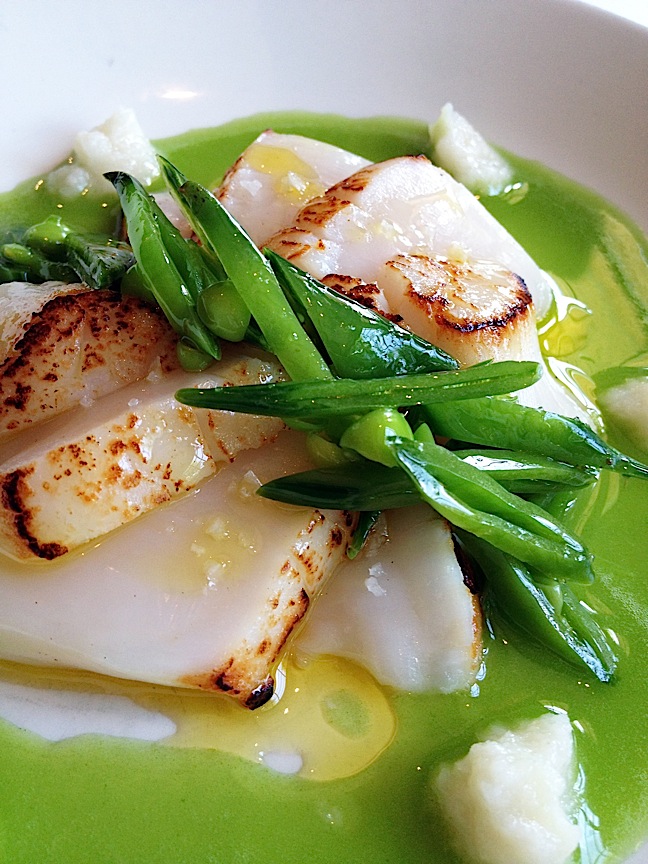 and
ceilings. The wine and beer list (with many
by the glass) is just right, with a good global
reach and plenty of bottlings under $50.
and
ceilings. The wine and beer list (with many
by the glass) is just right, with a good global
reach and plenty of bottlings under $50.
I found most of what I sampled
with three other people quite good, from seared
scallop crudo
(therefore not really "crudo") with snap peas and a
bite of horseradish, to grilled octopus and pork
lettuce wraps with a pungent Vietnamese
sauce. Broiled Gulf shrimp done scampi style
on toast had plenty of flavor, and there's
everything to love about good old fish and
chips--the batter light and greaseless, the white
Acadian redfish delicious and moist, served with
good fries drizzled with tangy malt vinegar.
Simple but satisfying was pan-fried sole in
breadcrumbs with tangy capers, brown butter, and
sautéed spinach. When trout is done
well, as it is here, it's a very savory fish, and
I liked the idea of its being grilled whole to
keep in the juices, served with pickled ramp
butter and new potatoes. This being the South, the
kitchen needs a lesson or two in what a true New
England clam chowder should taste like.
Of course,
you will want to try the citrus tart with Georgia
pecans and whipped cream or the warm apple pie for
two with buttermilk ice cream.
Lure is open for lunch Mon.-Fri., for
dinner nightly, for brunch on Sun. Starters runs
$2.50-$12, other courses $8-$33.
by John Mariani
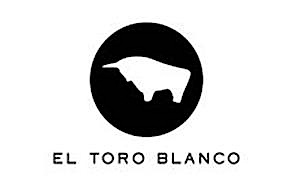
257 Avenue of the Americas
212-645-0193
eltoroblanco.com
To compare El Toro Blanco to Alma Cucina, above, is to understand a little about the difference in real estate in NYC versus Atlanta. I have no idea what either restaurant pays for rent, but in Atlanta the space itself is a pretty big deal, wide open, well lighted, and good for people watching. El Toro Blanco, on the other hand, in NYC's Greenwich Village, is cramped, darkened, extremely loud, and with few sightlines around the room.
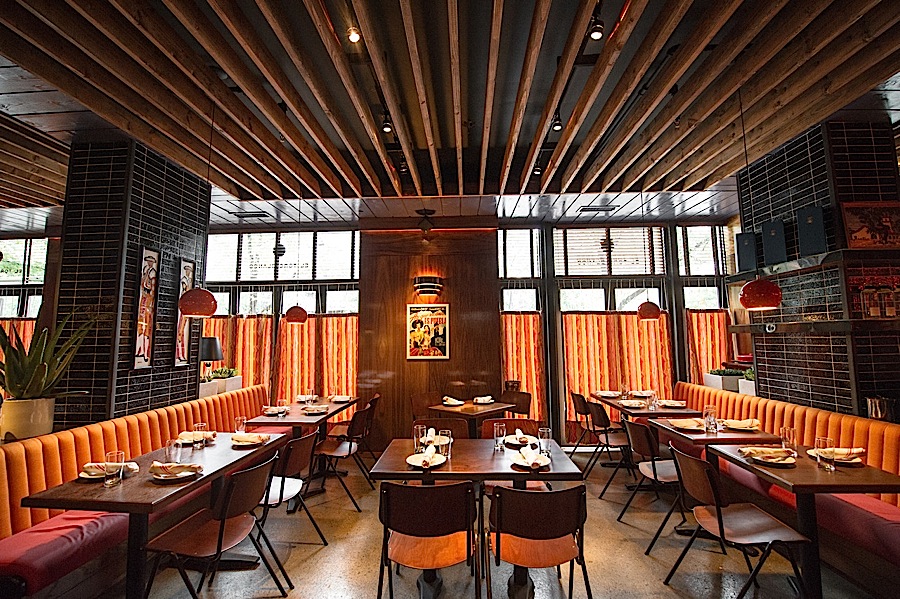 Prices are
higher at El Toro Blanco--$2 to $5 more for most
dishes. A "small" order of guacamole at
El Toro Blanco was $12, while a generous portion at
Alma Cucina was $6. But when it comes
to cocktails: at Alma Cucina the
margaritas made with Herradura Lay of the Land
tequila, poire william, and jalapeño is $9; a
blend of Herraduro El Centro resposado with
Fiednecio mezcal, ginger, chamomile is a dollar
more. But at El Toro Blanco, a margarita made
with Herradura añejo and Cointreau cost a
whopping $19! So our party of four spent
$72 on one round of drinks at El Toro Blanco, about
what they'd cost at one of those vast midtown
nightclubs like Tao. For a dollar more we
could have had a margarita at Restaurant Daniel or a
bellini at Harry Cipriani uptown.
Prices are
higher at El Toro Blanco--$2 to $5 more for most
dishes. A "small" order of guacamole at
El Toro Blanco was $12, while a generous portion at
Alma Cucina was $6. But when it comes
to cocktails: at Alma Cucina the
margaritas made with Herradura Lay of the Land
tequila, poire william, and jalapeño is $9; a
blend of Herraduro El Centro resposado with
Fiednecio mezcal, ginger, chamomile is a dollar
more. But at El Toro Blanco, a margarita made
with Herradura añejo and Cointreau cost a
whopping $19! So our party of four spent
$72 on one round of drinks at El Toro Blanco, about
what they'd cost at one of those vast midtown
nightclubs like Tao. For a dollar more we
could have had a margarita at Restaurant Daniel or a
bellini at Harry Cipriani uptown. The reflex to say, "Hey, that's New York for you!" is to suggest that Atlanta is a cheap city, which it is not, and the food at El Toro Blanco was, by virtue of it being in New York, much better, which it was not. The simple thought of four of us spending $307 plus a 20 percent tip--with one bottle and two glasses of wine ($60) and no desserts at El Toro Blanco made me think that something is way out of whack.
Yet the place was packed and people were obviously enjoying themselves at this, one of the current downtown hot spots. The cooking is good at El Toro Blanco, although not inspired. The guacamole was all right (not made tableside--there's simply no room to do so), and the chorizo queso fundido was tasty enough. The best of the dishes we tried was a luscious short ribs empanada with Oaxacan cheese and ancho chile barbecue. Two orders of cabrito tacos went fast, but in many of the dishes the flavors were much the same, so that we were asking ourselves, "Is that the cabrito?" "Is that the chicken taco?" Swordfish, not an easy species to get right, was juicy, but shrimp tacos with Cuban slaw, roasted tomatoes and avocado were bland.
When I left the restaurant, which got louder as the night wore on, I felt a relief from the noise, the cramped tables, uncomfortable seating, and the thought that I'd learned a lesson.
El Toro Blanco is open for lunch Mon.-Fri., dinner nightly; Appetizers $9-$18, main courses $19-$26.
❖❖❖
SO, HOW ARE THE
BROWNIES?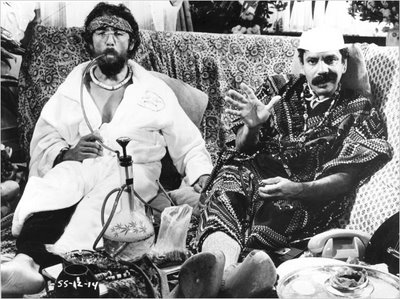
"Rickybobby is a great place for stoners. That's what I
was thinking as I sat in the month-old restaurant,
surrounded by a kaleidoscope of cartoonish colors and
images, half-watching Super
Troopers projected on one wall and trying
to avoid the glassy stare of a spooky taxidermy calf
with two heads. The food seems made for the munchies too
— totally filling, but you compulsively eat it anyway
because it tastes so good. The remarkable thing about
Rickybobby is that it helps you achieve a higher state
of being even if your mind isn't chemically
altered."--Anna Roth, "Rickybobby: Mind-(and
Body)-Expanding Comfort Food," SF Weekly (1/16/13).
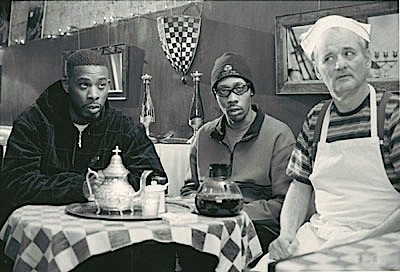
CALLING ALL CARS--CALLING ALL CARS--BE ON THE LOOK-OUT FOR A MAN DRINKING COFFEE IN THE STARBUCKS PARKING LOT--MAY BE ARMED AND EXTREMELY STUPID.
In
Huntsville, Alabama, a Starbucks
employee thwarted a would-be thief by offering him a free coffee instead of
cash, which the man accepted, then walked to the
parking lot where he was immediately arrested.
❖❖❖
Any of John Mariani's
books below may be ordered from amazon.com.
 |
My latest book, which just won the prize for best book from International Gourmand, written with Jim Heimann and Steven Heller, Menu Design in America, 1850-1985 (Taschen Books), has just appeared, with nearly 1,000 beautiful, historic, hilarious, sometimes shocking menus dating back to before the Civil War and going through the Gilded Age, the Jazz Age, the Depression, the nightclub era of the 1930s and 1940s, the Space Age era, and the age when menus were a form of advertising in innovative explosions of color and modern design. The book is a chronicle of changing tastes and mores and says as much about America as about its food and drink.
“Luxuriating vicariously in the pleasures of this book. . . you can’t help but become hungry. . .for the food of course, but also for something more: the bygone days of our country’s splendidly rich and complex past. Epicureans of both good food and artful design will do well to make it their coffee table’s main course.”—Chip Kidd, Wall Street Journal.
“[The menus] reflect the amazing craftsmanship that many restaurants applied to their bills of fare, and suggest that today’s restaurateurs could learn a lot from their predecessors.”—Rebecca Marx, The Village Voice. |
"Eating Italian will never be the same after reading John Mariani's entertaining and savory gastronomical history of the cuisine of Italy and how it won over appetites worldwide. . . . This book is such a tasteful narrative that it will literally make you hungry for Italian food and arouse your appetite for gastronomical history."--Don Oldenburg, USA Today. "Italian
restaurants--some good, some glitzy--far
outnumber their French rivals. Many of
these establishments are zestfully described
in How Italian Food Conquered the World, an
entertaining and fact-filled chronicle by
food-and-wine correspondent John F.
Mariani."--Aram Bakshian Jr., Wall Street
Journal.
"Equal parts
history, sociology, gastronomy, and just
plain fun, How Italian Food Conquered the
World tells the captivating and delicious
story of the (let's face it) everybody's
favorite cuisine with clarity, verve and
more than one surprise."--Colman Andrews,
editorial director of The Daily
Meal.com. "A fantastic and fascinating
read, covering everything from the influence
of Venice's spice trade to the impact of
Italian immigrants in America and the
evolution of alta cucina. This book will
serve as a terrific resource to anyone
interested in the real story of Italian
food."--Mary Ann Esposito, host of PBS-TV's
Ciao
Italia. "John Mariani has written the
definitive history of how Italians won their
way into our hearts, minds, and
stomachs. It's a story of pleasure over
pomp and taste over technique."--Danny Meyer,
owner of NYC restaurants Union Square Cafe,
Gotham Bar & Grill, The Modern, and
Maialino.
|
 |
 |
 |
 |
 |
 |
 |
 |
 Everett Potter's Travel Report:
Everett Potter's Travel Report: 
 Eating Las Vegas
is the new on-line site for Virtual Gourmet
contributor John A. Curtas., who since 1995
has been commenting on the Las Vegas food
scene and reviewing restaurants for Nevada
Public Radio. He is also the
restaurant critic for KLAS TV, Channel 8 in
Las Vegas, and his past reviews can be
accessed at KNPR.org.
Click on the logo below to go directly to
his site.
Eating Las Vegas
is the new on-line site for Virtual Gourmet
contributor John A. Curtas., who since 1995
has been commenting on the Las Vegas food
scene and reviewing restaurants for Nevada
Public Radio. He is also the
restaurant critic for KLAS TV, Channel 8 in
Las Vegas, and his past reviews can be
accessed at KNPR.org.
Click on the logo below to go directly to
his site.

Tennis Resorts Online: A Critical Guide to the World's Best Tennis Resorts and Tennis Camps, published by ROGER COX, who has spent more than two decades writing about tennis travel, including a 17-year stretch for Tennis magazine. He has also written for Arthur Frommer's Budget Travel, New York Magazine, Travel & Leisure, Esquire, Money, USTA Magazine, Men's Journal, and The Robb Report. He has authored two books-The World's Best Tennis Vacations (Stephen Greene Press/Viking Penguin, 1990) and The Best Places to Stay in the Rockies (Houghton Mifflin, 1992 & 1994), and the Melbourne (Australia) chapter to the Wall Street Journal Business Guide to Cities of the Pacific Rim (Fodor's Travel Guides, 1991).


MARIANI'S VIRTUAL GOURMET
NEWSLETTER is published weekly. Editor/Publisher: John
Mariani.
Contributing Writers: Christopher Mariani, Robert Mariani,
John A. Curtas, Edward Brivio, Mort Hochstein,
Suzanne Wright, and Brian Freedman. Contributing
Photographers: Galina Stepanoff-Dargery,
Bobby Pirillo. Technical Advisor: Gerry McLoughlin.
© copyright John Mariani 2013
